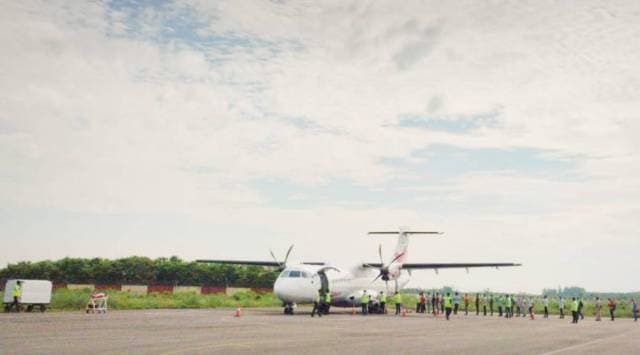- India
- International
In Assam, a defunct World War II airstrip takes wings again
After lying abandoned for decades, Rupsi was finally redeveloped under the Central government’s UDAN scheme last month, spelling hope for not just lower Assam, which borders Bangladesh, but Bengal and Meghalaya too.
 Located in Kokrajhar district, close to the border of Dhubri district, Rupsi was once a strategic airstrip that housed warplanes during World War II. (Photo: Twitter @Rupsi Airport, Assam)
Located in Kokrajhar district, close to the border of Dhubri district, Rupsi was once a strategic airstrip that housed warplanes during World War II. (Photo: Twitter @Rupsi Airport, Assam)On May 8, as the ferocious second wave of the pandemic gripped the country, a 72-seater plane touched down the tarmac of an airport in lower Assam, to a water cannon salute. The 24 passengers who landed were gifted gamosas and aronais (Bodo scarves), amid muted cheers of the small crowd gathered there. ‘Welcome to Rupsi airport’ they were told.
“There was a reason to celebrate,” said Jyotirmoy Chakraborty, a journalist and resident of Dhubri town, located 15 km from the airport. “The flight to Rupsi would become a part of history.”
Thank You all🙏
Your support, cooperation, love and our services will make #RupsiAirport a pleasant experience.#NorthEast #Assam #aviation @MoCA_GoI @MDoNER_India @CMOfficeAssam @PIB_Guwahati @AAI_Official @diprassam pic.twitter.com/e8O9wQSOnj
— Rupsi Airport, Assam (@aairupairport) May 9, 2021
Located in Kokrajhar district, close to the border of Dhubri district, Rupsi was once a strategic airstrip that housed warplanes during World War II. After lying abandoned for decades, it was finally redeveloped under the Central government’s UDAN scheme for regional connectivity last month, spelling hope for not just lower Assam, which borders Bangladesh, but Bengal and Meghalaya too.
“To catch a flight we had to travel 300km to Guwahati or to Siliguri in Bengal, 250km away. This easily took six to seven hours — a duration sometimes longer than the flight itself,” said Chakraborty.
A strategic airstrip
Built on almost 3,000 bighas of tea garden land by the British, Rupsi became a strategic location for the Allied forces during World War II. “It was located in the middle of a jungle and was perfect for war planes. The British built about 52 camouflaged hangars in Rupsi — these met strategic and operational requirements for the war,” said Bijay Sharma, writer and journalist from Dhubri.
Masud Zaman, a lawyer based in Dhubri, said that Rupsi was possibly the longest airstrip in Asia during the world war. “People forget how important it was — this was the nerve centre, the supply line source for forces in Burma and China,” he said.

 Built on almost 3,000 bighas of tea garden land by the British, Rupsi became a strategic location for the Allied forces during World War II. (Photo: Twitter @Rupsi Airport, Assam)
Built on almost 3,000 bighas of tea garden land by the British, Rupsi became a strategic location for the Allied forces during World War II. (Photo: Twitter @Rupsi Airport, Assam)
However, several developments led to its decline post independence. ”The Bangladesh Liberation war in 1971 led to different protocols in the newly-formed country, and the frequency of visits by businessmen from Bangladesh reduced considerably. Following that was the Emergency,” said Sharma.
Chakraborty added that the anti-‘foreigner’ Assam Agitation, which started in 1979, also played a part in slowing down travel to Kolkata. “Then came the Bodo movement which made the area more sensitive,” he said. It was unfortunate because Dhubri, a river port, had been the gateway to the Northeast during the British era, and a thriving area for trade.
“Moreover, this part of Assam always had a good connection with Bengal…Kolkata whether it was for marriages or business,” said Trinayan Bhuyan, SDPO, Kokrajhar, who was earlier the Deputy SP in Dhubri.
In 1983, the last commercial flight took off from Dhubri to Guwahati. In the years that followed, the airport became defunct, abandoned and overrun by weeds and undergrowth.
A push for revival
Just as how different political events led to the decline of Rupsi, it was political pressure again that led to its reopening —through the years, several politicians from lower Assam, as well as civil society groups, kept up the demand for the airport.
Nearly 15 years ago, Chakraborty, Sharma and a few like-minded residents (businessmen, journalists, social workers) of Dhubri formed the ‘Rupsi Airport Revival Demand Committee’. “It had only one objective – to make planes fly from Rupsi,” Chakraborty said.
Politicians like AIUDF’s Badruddin Ajmal, who is an MP from the Dhubri Lok Sabha seat, played a role in the revival, writing to different ministries, asking questions in the Lok Sabha, to push for the airport.
Bimal Oswal, a member of the airport revival committee, said the airport (located 15 km away from Dhubri, and 70 km from Bodo Territorial Council headquarters, Kokrajhar) was crucial because lower Assam, which borders Bangladesh, is virtually cut off from the rest of the state. “Dhubri has low development, poor connectivity and communication. So people do not visit here easily – moreover there are a lot of students who are now outside, for them it is difficult,” he said.
In 2017, when the civil aviation ministry’s UDAN scheme was announced there was a renewed hope for Rupsi. “A number of legislators like Hagrama Mohilary, Badaruddin Ajmal, UG Brahma kept the pressure up,” said Chakraborty, “The second Bodo accord, which was signed in 2003, also had a clause for an airport — that helped.”
But it was only in 2020, under the fourth round of UDAN regional connectivity scheme, that Rupsi became functional, after it was redeveloped by the Airport Authority of India at Rs 69 crore.
Rupsi 2.0
Rupsi will cater to passengers from north Bengal (Alipurduar and Cooch Behar districts), lower Assam’s Dhubri, Kokrajhar, Bongaigaon, South Salmara districts, as well as Meghalya’s Garo Hills.
Despite the pandemic there are at least 60 to 70 passengers using the airport everyday, said Jyotirmoy Barua, airport manager, Rupsi. Currently, there are four Flybig flights operating the Kolkata-Guwahati-Rupsi every week. “It was practically a jungle before it was revived,” he said, “We have used the old 1.8-km-long runway, just strengthened and re-carpeted it, the terminal building is a pre-fabricated structure.”
Zaman said he was happy that the airport was functional again but worried about its feasibility. “Many airports like the Tura airport (Meghalaya) had opened but closed again later because of lack of commercial feasibility. Hopefully that does not happen in Rupsi,” he said.
Buzzing Now
May 03: Latest News
- 01
- 02
- 03
- 04
- 05





































